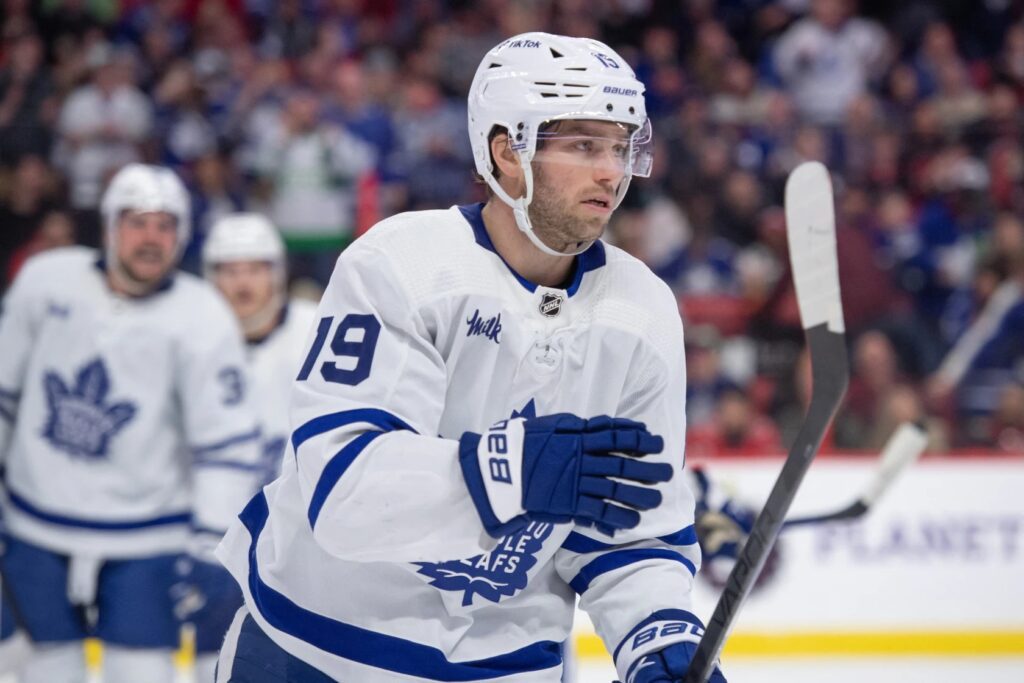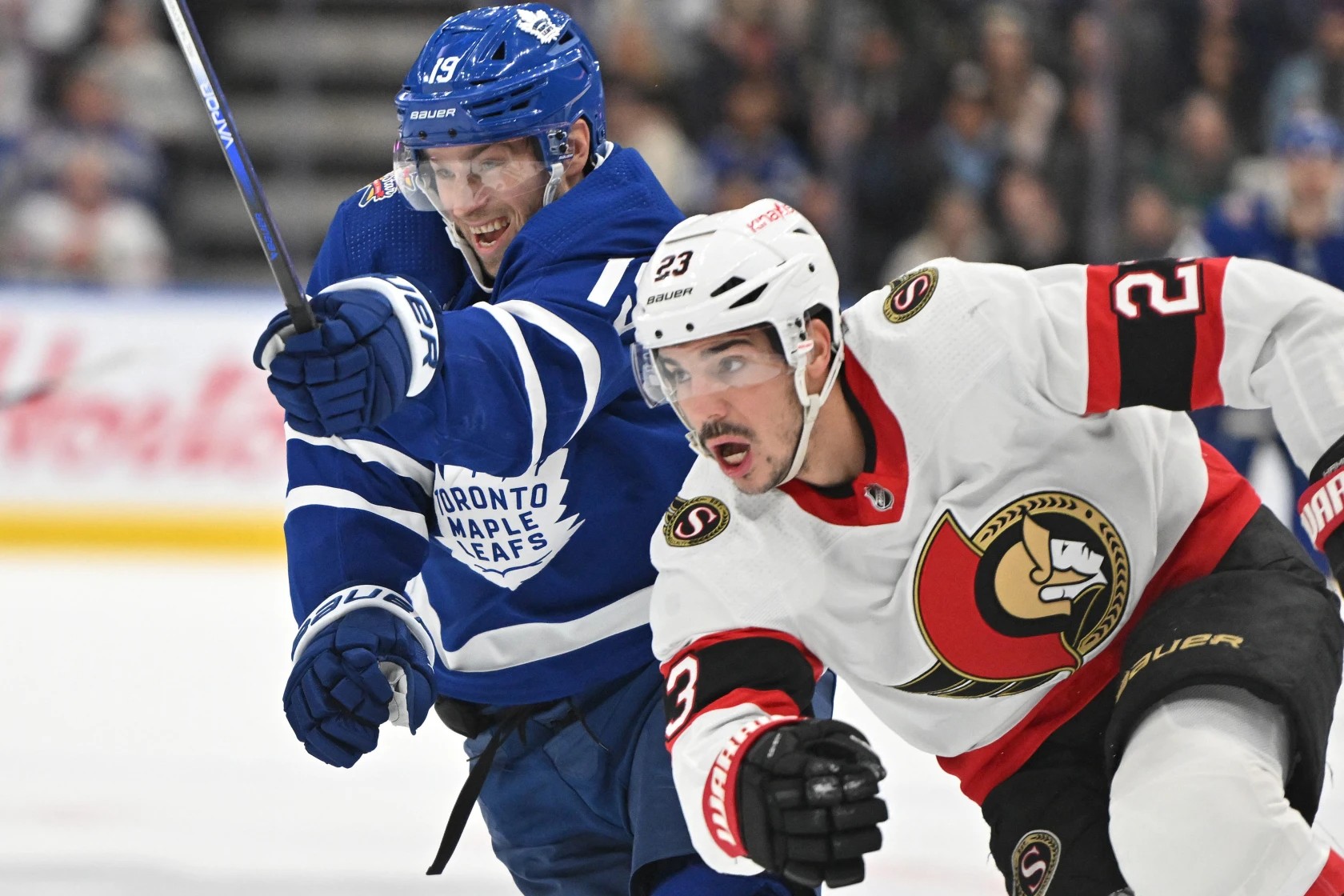As the Offseason Evaluations series continues, we’re now assessing the Maple Leafs’ secondary forwards currently under contract for the 2024-25 season, starting with David Kampf and Calle Jarnkrok.
In my previous two pieces, I reviewed the 2023-24 seasons of the core four forwards and discussed the expectations and potential usage of each player next season:
- Offseason Evaluations, Part 1: Auston Matthews & William Nylander
- Offseason Evaluations, Part 2: Mitch Marner & John Tavares
David Kampf

| David Kampf | |
|---|---|
| 2023-24 Production | 8 goals and 19 points in 78 games (13:29 per game) |
| 5v5 Results | 46.61 CF% | 43.17 xGF% | 26 goals for, 34 goals against |
| Contract Status | Three years remaining at $2.4 million AAV (10 team no-trade list) |
Fresh off a new long-term contract, David Kampf experienced a challenging season. He spent the first half of the season playing primarily with Noah Gregor and Ryan Reaves, a far cry from regular linemates such as Ilya Mikheyev, Alex Kerfoot, and Pierre Engvall of years past. Those previous lines had a clear identity, and Kampf did well in the role – they were strictly a matchup and shutdown unit, where Kampf fits naturally as a strong defensive center.
Centering Gregor and Reaves left Kampf in a tough spot, and it showed. Neither winger is good enough defensively to build a defensive line, and neither winger can produce enough to make it a credible two-way or depth-scoring line.
Early in the season, Kampf was moved up to center Max Domi and Matthew Knies as a defensive presence between two more offensively oriented wingers. It was oil and water as they struggled to gel and string together good shifts, even though they outscored opponents 3-0 (two of those goals came in one game against Tampa Bay).
Kampf returned to the fourth line, which eventually played its best game of the season against the Canucks in November when Bobby McMann was called up and inserted alongside Kampf and Gregor. The line scored twice, including Kampf’s first of the season. It was only a brief flash from the fourth line, though, as they often otherwise looked confused about their role and struggled with consistency from game to game. It culminated in a healthy scratch for Kampf following a game in Columbus where he tried to make a play with the puck in the offensive zone, leading to a turnover before the Blue Jackets scored a terrible goal on Ilya Samsonov from far out.
The other factor of note regarding Kampf’s season is that the penalty kill was poor throughout the season. Kampf was a shorthanded staple, leading all Leafs forwards in shorthanded time on ice per game. How much of it was specifically Kampf’s fault is up for interpretation. The Leafs had no right-handed penalty-killing defensemen for most of the season, leading to all sorts of problems. They also lacked penalty-killing forwards, and attempts to manufacture penalty killers came with all sorts of learning curves and mistakes.
Notably, the penalty kill was better and more aggressive in a nine-game run when Kampf paired up with Dewar on the top penalty-killing unit instead of his regular running mate Mitch Marner, who is more methodical than Dewar in the role. Even in the playoffs, Kampf was only on for two of the six goals the Leafs surrendered on the penalty kill. Nonetheless, he is one of the unit’s leaders, and they were a major liability. He has to wear some of the blame.
At 5v5, the second half of the season was a bit of a different story for Kampf. Ryan Reaves improved, Noah Gregor was often healthy scratched, Pontus Holmberg settled into an NHL role, and eventually, Connor Dewar was acquired from Minnesota. The fourth line started playing much better hockey.
Holmberg and Kampf, for example, started 35 percent of their faceoffs in the offensive zone, drew even in shot attempts, and outscored opponents 4-2 in 110 5v5 minutes together (with a positive expected goals mark). When Kampf played with Dewar, they logged over 135 minutes 5v5 minutes together, and while they were a little underwater at 5v5 overall in terms of shot attempts (47%) and actual goals (7-5), they also started just 26% of their shifts in the offensive zone.
Sheldon Keefe regularly buried Kampf’s line in tough situations against top players to see how they would hold up down the stretch. Kampf was 14th in the league in total defensive-zone faceoffs taken, and I’d argue nobody ahead of him had consistently worse linemates.
Much like in the past two seasons, when he played with reasonable linemates, Kampf was able to find ways to contribute to the team. During the playoffs, the fourth line served as an energy unit and produced several good games for the Leafs. Kampf scored in Game 1—although the contest was largely over by that point—and Jim Montgomery eventually switched his line matchups to account for the Leafs’ fourth line dominating the walls at times with energetic cycle shifts.
If the coaching staff isn’t going to use Kampf in a matchup role—which would mean his ice time would be well over 15 minutes per game—they need their fourth unit to be an energetic cycle line that wears down opposing defenses. They produced long stretches of that kind of play in the final two to three months once Kampf’s linemates improved. Over the final two months of the season, Kampf scored 11 points in 32 games, which is a modest total, but it is a 28-point pace over 82 games and is in line with his previous 26- and 27-point seasons.
Decent NHL centermen are hard to find – there are maybe three good ones hitting the open market this summer – and that would give the 29-year-old some modest value should they need to move off his contract and go cheaper at the position. If Brad Treliving holds onto Kampf, he provides utility as a checking center on an energetic fourth line. If he needs to open up cap space, exploring the market would also be understandable. It’s unlikely that Holmberg and his career 44.3% faceoff mark can readily slide into Kampf’s heavy defensive usage, but if the club is tight on cap room, sometimes concessions must be made.
Calle Jarnkrok

| Calle Jarnkrok | |
|---|---|
| 2023-24 Production | 10 goals and 21 points in 52 games (15:15 per game) |
| 5v5 Results | 50.98 CF% | 52.05 xGF% | 33 goals for, 22 goals against |
| Contract Status | Two years remaining at $2.1 million AAV (10 team no-trade list) |
Jarnkrok played just 52 games in 2023-24 due to injury. He broke his knuckle and returned only to suffer another hand injury. When he was in the lineup, Jarnkrok was his usual self, matching his career average goal per game rate (.19) and producing essentially at his career average points-wise (.4 this season versus .43 for his career) while providing dependable two-way play up and down the lineup. He is a dependable professional who brings an honest effort night in and night out.
Early in the season, Jarnkrok’s solid defensive play stood out on a Leafs team that was struggling defensively. In November, he also chipped in eight points in 12 games. At times, Keefe arguably overused Jarnkrok, including placement on the Leafs’ 6v5 offensive unit for most of the first half of the season. From the start of the season through the Christmas break, Jarnkrok was sixth among Leafs forwards in time on ice per game. While he is a fine enough player to move up the lineup in spot duty, the reality is that he’s not a regular top-six forward, as he doesn’t score enough or drive play/dominate defensively to justify the usage.
In the playoffs, Jarnkrok played on the third line and averaged 13:57 per game, which is more in line with where he should be slotted. His linemates, Pontus Holmberg and Nick Robertson, were both new to the playoffs, and as we have said a million times in this space, the playoffs are not a place where rookies and young players generally thrive. Unsurprisingly, they didn’t in Holmberg and Robertson’s case. That didn’t put Jarnkrok in a position to succeed, and he was held pointless in the playoffs.
Slow playoff production has become a trend for Jarnkrok, who has scored just five goals and 22 points in 93 career playoff games. In 18 playoff games as a Leaf across two seasons, he has one goal, which came in the third period of a game the Leafs were losing 7-2 (it did not spark a heroic comeback).
We have a very clear idea of who Jarnkrok, 33 in September, is as a player. He chips in some offense, can take a solid regular shift, is an honest player who doesn’t cheat the game, and has some reasonable versatility. He can line up in all three forward positions (though I think he’s much more effective on the wing than at center), play a part in a penalty-killing rotation, and if he plays with linemates who can set him up, he can bury with his nice shot. But he’s not going to drive a line, and he’s not going to drive offense in the playoffs.
A few years ago, the Flames traded second, third, and seventh-round picks for Jarnkrok at the deadline, and I’m not sure if his value has shrunk much. He’s pretty much the same player and his $2.1 million salary is more than fine for a top-nine forward. On one hand, that’s also an argument for keeping Jarnkrok.
Elliotte Friedman is already floating the notion that the market for depth forwards will be pricey. For a Leafs team with massive holes on defense, it doesn’t make much sense to flip Jarnkrok for a pick only to turn around and overpay a different type of depth player for even more money. Where it could get interesting, though, is if they flipped Jarnkrok for a pick and filled his position internally, be it someone like Pontus Holmberg, Nick Robertson, Easton Cowan, or a surprise emergence like Nikolay Grebonykin.
The Leafs have no picks in the first four rounds of 2025. They cannot be buyers at the next trade deadline even if they want to. They need to acquire some picks, and perhaps there’s an avenue to doing so here. They could develop a younger player for the first half of the season, bank extra cap space in the process, and then flip the pick (or others) for a veteran upgrade with some playoff-scoring pedigree at the trade deadline (a team like Washington makes sense to me; Spencer Carbery was a Leafs assistant coach when Jarnkrok scored 20 goals). It will be difficult for the Leafs to attract players without overpaying, and they have three second-round picks in 2025.
Like many of the Leafs’ offseason plans, it really starts with what happens with Marner. If they keep Marner, it makes more sense to stockpile a draft pick or two. If they trade Marner, a decision on Jarnkrok would totally depend on the return.
Next up in the Offseason Evaluations series: Bobby McMann & Matthew Knies


![Craig Berube on Easton Cowan rejoining the Leafs: “He’s given us some really good games… The [demotion] was just a move made for roster reasons, but he’s back” Craig Berube, Toronto Maple Leafs head coach](https://mapleleafshotstove.com/wp-content/uploads/2025/04/berube-craig-leafs-prac-218x150.jpg)











![John Gruden after the Leafs prospects’ 4-1 win over Montreal: “[Vyacheslav Peksa] looked really comfortable in the net… We wouldn’t have won without him” John Gruden, head coach of the Toronto Marlies](https://mapleleafshotstove.com/wp-content/uploads/2025/09/gruden-post-game-sep-14-218x150.jpg)











![Craig Berube on Easton Cowan rejoining the Leafs: “He’s given us some really good games… The [demotion] was just a move made for roster reasons, but he’s back” Craig Berube, Toronto Maple Leafs head coach](https://mapleleafshotstove.com/wp-content/uploads/2025/04/berube-craig-leafs-prac-100x70.jpg)






